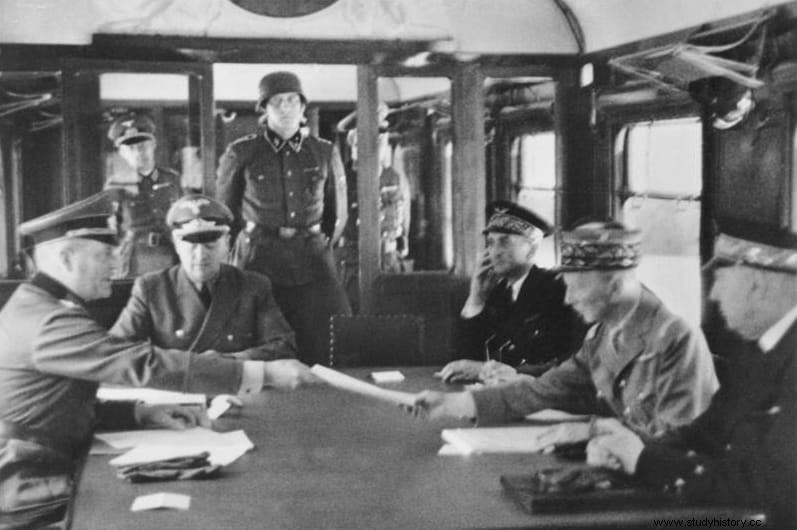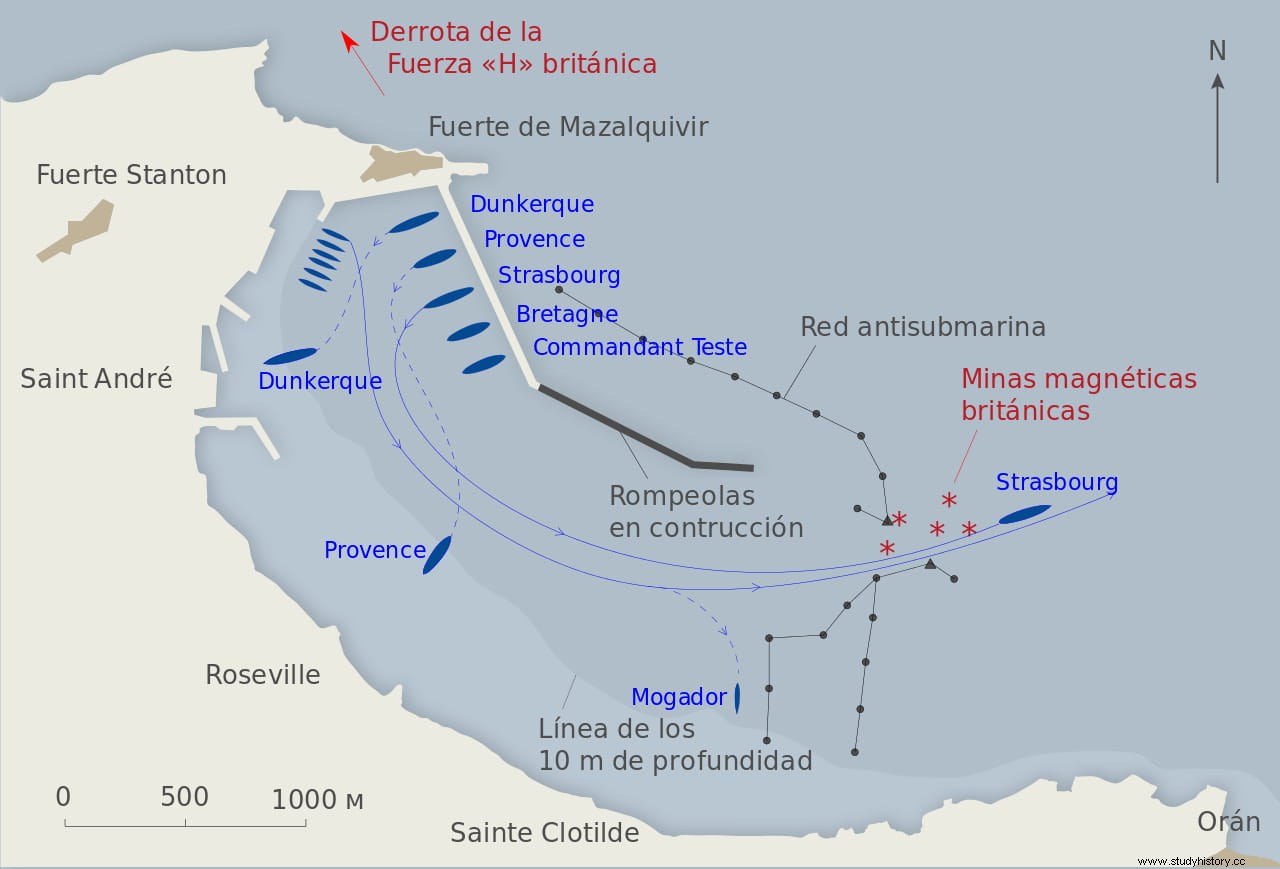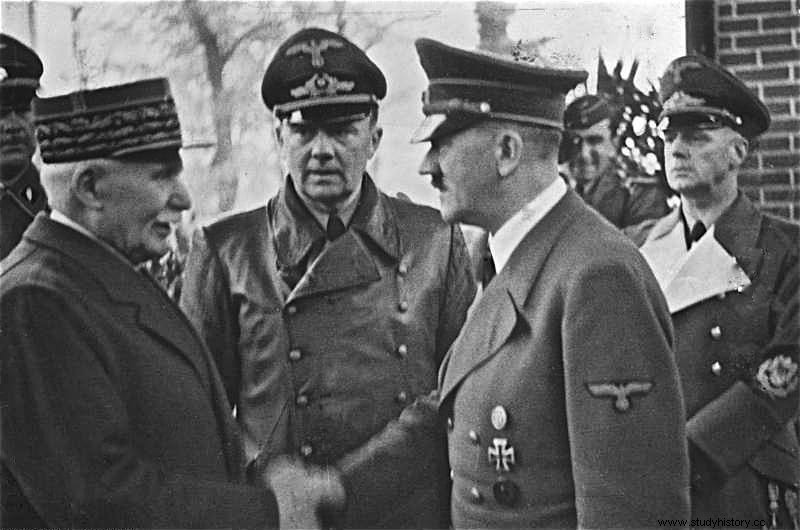The month of June 1940 was one of the most important of the Second World War, since throughout those four weeks events such as the evacuation of Dunkirk, the defeat of France against Germany and the consequent armistice of the 22nd took place. by which both countries ended hostilities. All three represented the triumph of Hitler and left the United Kingdom in a difficult situation, since not only was it losing its ally, but the French armed forces were in danger of falling into the hands of the Nazi regime, something especially serious considering that the Marine Nationale It was considered the fourth in the world, only behind the British, the American and the Japanese. That is why Churchill ordered its destruction, in what was dubbed Operation Catapult.
In fact, Hitler also wanted to prevent the Gallic fleet from taking refuge in Great Britain. And, indeed, the armistice signed in Rethondes aboard the same railway car in which the Compiegne armistice had been sealed during the First World War, included clauses in this regard in the twenty-four articles that made up the document.
Thus, at the military level, apart from the creation of an occupied zone next to a free one (the first, under direct control of the Wehrmacht, covering more than half of the territory), the obligation to provide supplies to the troops was stipulated. Germans and the order that warships anchor in their ports of peace and be demilitarized.

Mussolini wanted to keep those ships and four days before the signing he met with Hitler in Munich to present his ambitions:to occupy France up to the Rhône, annex Nice, Corsica and the two Savoys (Upper and Lower) and incorporate the Gallic naval units into the Marine Regia . But the Führer he wanted to avoid taking the French to the limit of what was acceptable, to the point that they preferred to resist at all costs, just as he did not want total control of the Mediterranean by Italy, since that could alienate him with Spain, so he did not agree to the requirement.
The final argument he gave to the Duce was that ordering the surrender of the navy might lead many of his captains to prefer to join the British. On the other hand, the French colonial empire was too extensive for the Kriegsmarine to could deal with him directly, which is why he opted to leave the powers over him in the hands of his executive (which at that time, after the resignation on the 16th of the President of the Council of Ministers, Paul Reynaud, was temporarily led by General Philippe Pétain, who on July 11 would go on to preside over the collaborationist Vichy government).
Indeed, both Pétain and Admiral François Darlan, Chief of Staff of the Navy, had previously agreed that they would reject the armistice if the Germans demanded the surrender of the fleet. The issue had been raised on June 11, when Churchill, with the Battle of France still in force but seeing the collapse of the front, questioned his allies about the fate of those ships in case of defeat.

Despite attempts to reassure him, five days later, before the clear negotiation of the armistice, the premier he insisted on sending two telegrams to Reynaud; in them he proposed that he send his navy to British or neutral ports.
The French reaction was angry, considering it an offense to doubt the guarantees offered by Darlan in this regard. Churchill apologized and the admiral wanted to make his position even clearer by issuing three strict orders to his captains:the first was the express prohibition of seeking refuge in foreign ports; second, that no ship should fall into German or Italian hands; and the third, that if there were attempts to seize them by force they should repulse them and then set sail for British or West Indian ports and, if necessary, sink them.

Indeed, eighty units of the Marina Nationale they began to concentrate in Africa (Alexandria, Mazalquivir, Casablanca and Dakar), while another hundred did so in Cherbourg, Brest, Lorient and Saint-Nazaire. Some that were unseaworthy were scuttled; others were in overseas regions; likewise, a hundred more were in England, in the ports of Plymouth and Portsmouth. But none of this served to allay Churchill's misgivings, and he withdrew his ambassador from Paris on the night of June 22. And when he found out about the terms of the armistice, he contacted Admiral Dudley Pound to take drastic action.
Darlan had promised him that he would destroy the fleet if Hitler imposed new conditions or tried to seize it. But, deep down, he was a Germanophile (he was appointed Minister of the Navy by Pétain and would become vice president) and was convinced that the Axis would also defeat the United Kingdom, which is why he did not want his ships to call at British ports, as they would fall anyway in Teutonic power.

Now, Churchill trusted the power of the Royal Navy as a guarantee against any maritime invasion, something that could only be unbalanced if the Kriegsmarine it was reinforced by French ships and closed off their maritime supply lines. There was no other solution than to sink them and for this he made what he himself defined as the hardest decision of his life:to launch Operation Catapult.
Dudley Pound, First Lord of the Admiralty, was a veteran seaman born on the Isle of Wight in 1877. During World War I he fought in the Battle of Jutland, commanding the battleship HMS Colossus , he sank the cruiser Wiesbaden . He then moved on to strategic tasks and was one of the designers of the Zebrugge Raid , a failed plan to block the German fleet in the Belgian port of Bruges by sinking old ships in the mouth. In 1940 he was in poor health (he would die of a stroke three years later, still in the middle of the war), but the British Prime Minister trusted him blindly and for this reason he was nicknamed Churchill’s Anchor (Churchill's Anchor).
Pound achieved some historical notoriety for managing to stop the German submarine campaign until it was reversed, but he was also widely criticized for ordering the dispersal of a convoy in the Barents Sea, leaving it defenseless and causing the loss of almost three quarters of its members. which is why there was no lack of commanders who considered him inept. In any case, it was Churchill who commissioned Operation Catapult, which took place between July 2 and 8 in various scenarios, due to the scattered nature of the objective, ruling out the more moderate alternatives proposed by other commands.

Logically, the first blow was at home. On the night of July 2 to 3, British troops took control of the French ships anchored in the aforementioned Plymouth and Portsmouth - plus Gibraltar - resorting to the old trick of the brotherhood dinner between officers. In total, two battleships (Paris and Courbet ), two light cruisers, eight destroyers, four submarines, ten warnings (small corvettes), seven torpedo boats and a hundred more smaller ships. There was only resistance in the torpedo boat Le Mistral and the submarine Surcouf (the largest in the world), with four deaths. With a few exceptions, such as the modern destroyer Le Triomphant , these were outdated units.
On the afternoon of the 3rd, the most dramatic episode of the operation took place:the battle of Mers el-Kébir (Mazalquivir). In that port of Oran, the fifth part of the French navy was concentrated, under the command of Vice Admiral Marcel-Bruno Gensoul, before whom the so-called H Force appeared. of the Royal Navy , a powerful squadron made up of the aircraft carrier Ark Royal , two battleships, one battlecruiser, two light cruisers, and two submarines, reinforced by eleven destroyers. His boss, Admiral James Sommerville, urged Gensoul to follow them to the French West Indies or the United States, or else sink the ships, committing himself to repatriate the crews. Otherwise, he would attack.

Actually, the governor of Martinique was a supporter of Pétain and the British knew it, but they assumed that Gensoul would refuse and fight, allowing the fleet to be destroyed. So it was. After the negotiations failed, a battle broke out in which, unable to manoeuvre, trapped in the port, the cruiser Dunkirk was put out of action. , battleships Provence and Bretagne , the destroyer Mogador , the corvette Rigault de Genouilly and the patrol boat Terre-Neuve . The Strasbourg cruise managed to flee and take refuge in Toulon; five destroyers and the seaplane carrier Commandant Teste were also saved. , but the death toll totaled one thousand two hundred and ninety-five, for only two from the enemy (and four planes), in what was the naval combat with the lowest number of casualties in the entire conflict. Still, Sommerville was criticized for falling short of total destruction.
The Vichy government broke off diplomatic relations with London, but it became clear that Churchill was prepared to pursue the war alone, and he also received the support of de Gaulle, who applauded the action. And the operation continued. The next day it was Alexandria's turn, where Admiral René-Émile Godfroy's Force X was located:a battleship, four cruisers, three torpedo boats, a submarine and several smaller ships. There arrived his British counterpart, Andrew Browne Cunningham, who, being known to the French, offered him not to attack if in exchange the other disobeyed the order received to set sail. He then presented him with three possibilities:join him, sink the ships, or agree to disarm them, staying in port.
After several hours of tension and pressure from their respective governments, which urged them to fight, Godfroy, who understood that he was inferior, accepted the last option, emptying the fuel tanks and removing the key parts for the operation of the cannons Over the following days, three-quarters of the French sailors disembarked, thus avoiding a repetition of the Mazalquivir tragedy. It should be added that this French squadron would join the Allied side three years later, in July 1943.

Where there was a new confrontation was in Dakar (current capital of Senegal), on the 8th. The most modern battleship of the French navy, the Richelieu, was anchored there. , which had sailed from Brest under the guise of heading for Great Britain and now threatened the South Atlantic routes. Besides, she wasn't alone; she was accompanied by destroyers Milan , Epervier and Fleuret , as well as two submarines and other auxiliary units. There was also an ultimatum that was rejected, so two Swordfish torpedo bombers that took off from the aircraft carrier HMS Hermes they launched themselves against the Richelieu , causing damage that worsened in September, when there was a second attack in the context of Operation Dakar (an attempted occupation of the colony); she was disabled for ten months.
One last scenario remained, the Caribbean, where that same month of June a part of the fleet had landed:the aircraft carrier Béarn (with one hundred and seven aircraft on board) and the cruisers Jeanne-d’Arc and Émil-Bertin (one of the fastest in the world); Commanded by Rear Admiral Rouyer, its mission was to transport three hundred tons of gold from the Bank of France to Canada, so the Antilles were only a stopover. They escaped the British attack at the last moment, when US President Franklin Delano Roosevelt personally intervened, convincing the commanders to agree to immobilize the ships, which remained blocked until June 1943.
To be exact, there were still some French units to deactivate in various places. In Casablanca, for example, in whose port was the battleship Jean Bart , but where there was no attack because the Royal Navy he judged it too dangerous, as the place was well defended. The same thing happened in Toulon or Algiers; not so in Canada, Suez, Singapore and Crete, where more ships were confiscated or sunk. Ultimately, the Gallic navy was left without a third of its navy, including seven of the main ships, thus making it up to Churchill for the Dunkirk fiasco. But not everything was positive.

That was a war de facto against Vichy France and many French, and especially from the colonies, experienced an anglophobic sentiment that was reflected in a drop in the enlistments carried out by De Gaulle. Likewise, the naval officers considered themselves betrayed by their allies and not a few willingly embraced the government. In fact, Pierre Laval, foreign minister, took advantage of this circumstance during the meeting between Pétain and Hitler in Montoire-sur-le-Loir, in October, to justify the collaborationist policy that the executive was going to develop.
For this reason, as of July 12, the strategy was changed, allowing ships to navigate in colonial waters and only intercepting those that could go to ports under German or Italian control. The French would not fight at sea against the Axis powers until 1943 and, even then, they sometimes had to do so against the Allies, as in the campaigns in Syria, Madagascar (Operation Ironclad) and the landing in North Africa.
